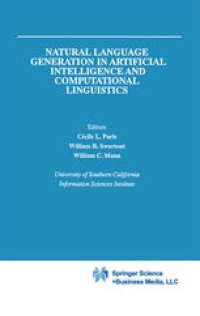
Ebook: Natural Language Generation in Artificial Intelligence and Computational Linguistics
- Tags: Artificial Intelligence (incl. Robotics), Computational Linguistics, Computer Science general
- Series: The Kluwer International Series in Engineering and Computer Science 119
- Year: 1991
- Publisher: Springer US
- Edition: 1
- Language: English
- pdf
One of the aims of Natural Language Processing is to facilitate .the use of computers by allowing their users to communicate in natural language. There are two important aspects to person-machine communication: understanding and generating. While natural language understanding has been a major focus of research, natural language generation is a relatively new and increasingly active field of research. This book presents an overview of the state of the art in natural language generation, describing both new results and directions for new research. The principal emphasis of natural language generation is not only to facili tate the use of computers but also to develop a computational theory of human language ability. In doing so, it is a tool for extending, clarifying and verifying theories that have been put forth in linguistics, psychology and sociology about how people communicate. A natural language generator will typically have access to a large body of knowledge from which to select information to present to users as well as numer of expressing it. Generating a text can thus be seen as a problem of ous ways decision-making under multiple constraints: constraints from the propositional knowledge at hand, from the linguistic tools available, from the communicative goals and intentions to be achieved, from the audience the text is aimed at and from the situation and past discourse. Researchers in generation try to identify the factors involved in this process and determine how best to represent the factors and their dependencies.
Content:
Front Matter....Pages i-xxii
Front Matter....Pages 1-1
A Reactive Approach to Explanation: Taking the User’s Feedback into Account....Pages 3-48
Generation and Explanation: Building an Explanation Facility for the Explainable Expert Systems Framework....Pages 49-82
Approaches to the Planning of Coherent Text....Pages 83-102
Focus of attention: Constraining what can be said next....Pages 103-124
Uncovering textual meanings: a case study involving systemic-functional resources for the generation of Japanese texts....Pages 125-153
The Implications of Revisions for Natural Language Generation....Pages 155-177
POPEL — A Parallel and Incremental Natural Language Generation System....Pages 179-199
Tailoring output to the user: What does user modelling in generation mean?....Pages 201-225
Front Matter....Pages 227-227
On the Place of Words In the Generation Process....Pages 229-247
Lexico(Grammatical) choice in text generation....Pages 249-292
Lexical Selection and Paraphrase in a Meaning-Text Generation Model....Pages 293-312
Front Matter....Pages 313-313
Referent Grammar In Text Generation....Pages 315-327
Segment Grammar: a Formalism for Incremental Sentence Generation....Pages 329-349
A Contrastive Evaluation of Functional Unification Grammar for Surface Language Generation: A Case Study in Choice of Connectives....Pages 351-396
Back Matter....Pages 397-403
Content:
Front Matter....Pages i-xxii
Front Matter....Pages 1-1
A Reactive Approach to Explanation: Taking the User’s Feedback into Account....Pages 3-48
Generation and Explanation: Building an Explanation Facility for the Explainable Expert Systems Framework....Pages 49-82
Approaches to the Planning of Coherent Text....Pages 83-102
Focus of attention: Constraining what can be said next....Pages 103-124
Uncovering textual meanings: a case study involving systemic-functional resources for the generation of Japanese texts....Pages 125-153
The Implications of Revisions for Natural Language Generation....Pages 155-177
POPEL — A Parallel and Incremental Natural Language Generation System....Pages 179-199
Tailoring output to the user: What does user modelling in generation mean?....Pages 201-225
Front Matter....Pages 227-227
On the Place of Words In the Generation Process....Pages 229-247
Lexico(Grammatical) choice in text generation....Pages 249-292
Lexical Selection and Paraphrase in a Meaning-Text Generation Model....Pages 293-312
Front Matter....Pages 313-313
Referent Grammar In Text Generation....Pages 315-327
Segment Grammar: a Formalism for Incremental Sentence Generation....Pages 329-349
A Contrastive Evaluation of Functional Unification Grammar for Surface Language Generation: A Case Study in Choice of Connectives....Pages 351-396
Back Matter....Pages 397-403
....